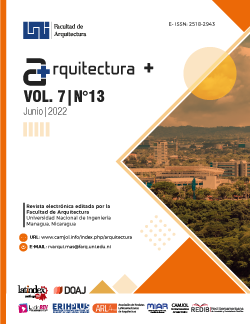In retrospect; contributions of urban planning instruments in the city of Managua, Nicaragua
DOI:
https://doi.org/10.5377/arquitectura.v7i13.14491Keywords:
urban planning, urban plans, urban projects, urban development, city of ManaguaAbstract
This article analyzes the main urban planning instruments developed for the city of Managua between 1954 and 2017. It addresses in an articulated way, from a historical and socio-cultural understanding, the causes that motivated their designs, as well as their scope, perspectives, general foundations, main projects, contributions and direct effects on the city.
As an exercise of historical articulation, it records and evaluates chronologically, urban policies and their intentions, their temporal, practical and instrumental character. With the fundamental purpose of relating spatial phenomena and other tangible expressions in the city, with the practice of organizing and projecting the territory. Part of the purpose of this study is to demonstrate the transcendence of urban planning, as well as its impact on people's lives and on the contemporary city, based on the critical vision of the authors and the reflections that some researchers have had on the city, its evolution and its processes.
Downloads
668
References
Agencia de Cooperación Internacional del Japón (2017). Proyecto del Plan Maestro para el Desarrollo Urbano del Municipio de Managua en la República de Nicaragua. Alcaldía de Managua.
Aguirre-Sacasa, F. X. (2002). Un Atlas Histórico de Nicaragua= Nicaragua an historical atlas. Fundación Uno.
Alcaldía de Managua (1954). Plan Regulador para Managua. ALMA.Alcaldía de Managua (1968). Plan Regulador para Managua. ALMA.
Alcaldía de Managua (1973). Plan Regulador para su Reconstrucción y Desarrollo. ALMA.
Alcaldía de Managua (1975). Programa de Reconstrucción de Acción Inmediata. ALMA.
Alcaldía de Managua (1975). Propuesta General de Desarrollo Urbano. ALMA.
Alcaldía de Managua (1982). Plan Regulador para Managua. ALMA.
Alcaldía de Managua (1987). Esquema de Desarrollo Urbano para Managua, 1987 – 2020. ALMA.
Alcaldía de Managua (1994). Plan Maestro para el Área Central de Managua. ALMA.
Alcaldía de Managua (1998). Planes Parciales de Ordenamiento Urbano, 1998 – 2000. ALMA.
Alcaldía de Managua (2002). Plan General de Desarrollo Municipal. ALMA.
Alcaldía de Managua (2005). Planes Parciales de Ordenamiento Urbano, sectores Norcentral, Suroccidental y Oriental del Municipio de Managua. ALMA.
Alcaldía de Managua (2017). Plan de Revitalización del Centro Tradicional y Patrimonial de Managua. ALMA.
Alcaldía de Managua (2017). Plan Maestro de Desarrollo Urbano de la ciudad de Managua. ALMA.
Almandoz, A. (2007). Modernización urbanística en América Latina. Luminarias extranjeras y cambios disciplinares, 1900-1960. Iberoamericana (2001-), 59-78.
Banco Interamericano de Desarrollo (2013). Plan de Acción de Managua Sostenible. BID.
Barrios, P. (2021). Los efectos de la red vial en el comportamiento de viaje de las personas. RevistaArquitectura +, 6(11), 2–20. https://doi.org/10.5377/arquitectura.v6i11.11722
Carrión, F. (2001). Centros Históricos de América Latina y el Caribe. FLACSO.
Carrión, F. (2005). El centro histórico como proyecto y objeto de deseo. Revista EURE, 31 (93), 89-100.
Castells, M. (1971). Problemas de Investigación en Sociología Urbana. Siglo XXI de España Editores.
González, M. (2017, 30 de marzo). Notas sobre el origen de Bello Horizonte. El Nuevo Diario. https://www.elnuevodiario.com.ni/nacionales/managua/423300-notas-origen-bello-horizonte/#:~:text=El%20inicio%20de%20Bello%20Horizonte,Ter%C3%A1n%2C%20el%20dise%C3%B1ador%20del%20residencial.
Gutiérrez, D. (2020). El nuevo modelo de convivencia urbana: los enclaves habitacionales auto-segregados en Managua. Revista Arquitectura +, 5(10), 2–19. https://doi.org/10.5377/arquitectura.v5i10.10558
Gutiérrez, D. (2021). Expansión metropolitana de la ciudad de Managua. Revista Arquitectura +, 6(12), 86–100. https://doi.org/10.5377/arquitectura.v6i12.13102Harvey, D. (2013). Ciudades rebeldes: del derecho de la ciudad a la revolución urbana. Ediciones Akal.
Instituto Nicaragüense de Estadísticas y Censos (2005). VIII Censo de Población y IV de Vivienda, 2005.INEC.
Inzulza J. & López, N. (2014). Gentrificación de escala intermedia global en Latinoamérica. El caso de la reconstrucción de Managua, Nicaragua 1972-2014. Revista de Urbanismo, 16(31), Pág. 56–75. https://doi.org/10.5354/ru.v16i31.33274
Inzulza, J, & Galleguillos, X. (2014). Latino gentrificación y polarización: transformaciones socioespaciales en barrios pericentrales y periféricos de Santiago, Chile. Revista de geografía Norte Grande, (58), 135-159. https://dx.doi.org/10.4067/S0718-34022014000200008
Janoschka, M. (2002). El nuevo modelo de la ciudad latinoamericana: fragmentación y privatización. Revista EURE, 28 (85), 11-29.
López -Maltez, N. (1997). Managua 1972.N.L.M. Publishing, Inc.
López, N. (2016). Urbanización desigual en la ciudad de Managua, de 1995 a 2015 (documento de trabajo). http://biblioteca.clacso.edu.ar/clacso/becas/20160331030347/Informe.pdf
Rodgers, D. (2006). Desimbricando la ciudad: crimen, inseguridad y organización espacial en Managua, Nicaragua. Encuentro. (73), 8-24.
Solís, A. (2017). Archivo fotográfico de la ciudad de Managua. Álvaro Solís
Suárez, B. & López, N. (2015). Segregación socio-residencial en la ciudad de Managua. Cuaderno de Investigación 30. UCA Publicaciones.
Suárez, B. & López, N. (2016). Formas de expresión de la segregación urbana en la ciudad Managua. Revista Arquitectura +, 1(2), 53–71. https://doi.org/10.5377/arquitectura.v1i2.9204
Downloads
Published
How to Cite
Issue
Section
License
Copyright (c) 2022 Universidad Nacional de Ingeniería

This work is licensed under a Creative Commons Attribution-NonCommercial-NoDerivatives 4.0 International License.



















